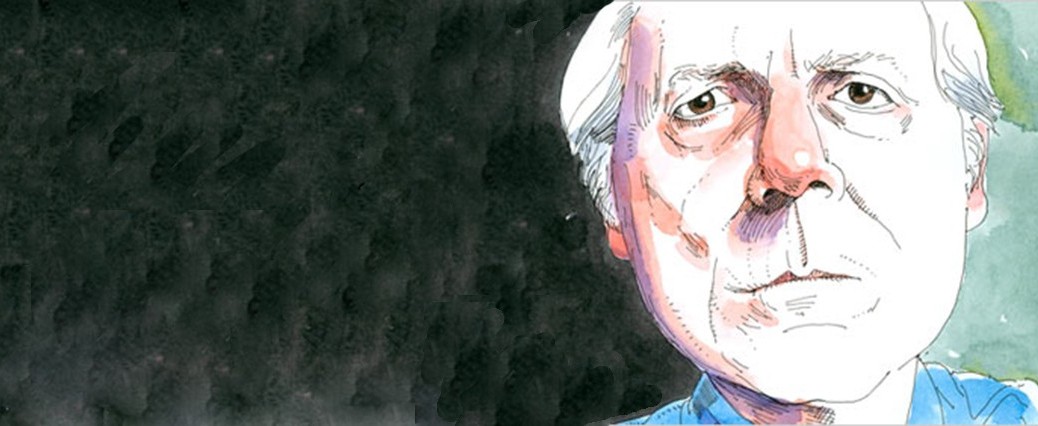Newsletter 7.1 (2013)
-Aaron DeRosa
“Very terrible thing but you have to look at it, I think.”
“Yes, you have to look.”
~ Don DeLillo, Underworld
Given his fascination with the twinned existence of the towers, it makes sense why Don DeLillo would be so drawn to the figure in Richard Drew’s September 11, 2001 photo, “Falling Man,” the titular image of DeLillo’s fifteenth novel. Tom Junod said of the unidentified man in the photo, “He splits them, bisects them: Everything to the left of him in the picture is the North Tower; everything to the right, the South. Though oblivious to the geometric balance he has achieved, he is the essential element in the creation of a new flag, a banner composed entirely of steel bars shining in the sun.” Junod’s elegy to the two towers resonates throughout DeLillo’s fiction, which has consistently come back to this detail. In Mao II, photographer Brita Nilsson comments on their twinned existence to the aging author, Bill Gray: “But having two of them is like a comment, it’s like a dialogue, only I don’t know what they’re saying” (40). For DeLillo, the towers speak of their own destruction, and continue to do so even after their collapse.
In White Noise, DeLillo references the “Law of Ruins,” the philosophy that underlay German architect Albert Speer’s desire to “build structures that would decay gloriously, impressively, like Roman ruins. No rusty hulks or gnarled steel slums” (246). First proposed by John Ruskin, the Law of Ruins holds that the final record of a civilization is its architecture, and thus the chief purpose behind a design was posterity. “The ruin is built into the creation . . . which shows a certain nostalgia behind the power principle, or a tendency to organize the longings of future generations.” For DeLillo, we build in the present with a mind toward the future’s vision of the past. And by controlling this future self-image, by allowing our ruins to speak of our glory, a civilization demonstrates its true power.
DeLillo expands on this sentiment in Underworld, a novel oft-discussed in the post-9/11 period for its ominous cover that features the WTC towers in a fog, a giant bird visible in the distance and a church cross bisecting the two towers. (The story goes that DeLillo selected the cover image but felt it too heavy-handed. When Scribner assigned the task to an independent researcher, they independently settled on the same image.) The novel is largely about building towers of waste, and DeLillo juxtaposes the Fresh Kills landfill with the Twin Towers (again, oddly forecasting the main site of the WTC detritus). Surveying the tower of refuse, waste manager Nick Shay finds “the sight inspiring. All this ingenuity and labor, this delicate effort to fit maximum waste into diminishing space. The towers of the World Trade Center were visible in the distance and he sensed a poetic balance between that idea and this one” (184). The nature of that balance seems to rest in the unseen relationship between what has been discarded, and what will be discarded, and how both speak to the nation’s glory.
The juxtaposition of the towers against the landfill speaks to the inevitability of their collapse. DeLillo says as much when he brings these disparate comments together in Falling Man where art critic Ernst Hechinger rhetorically asks,
But that’s why you built the towers, isn’t it? Weren’t the towers built as fantasies of wealth and power that would one day become fantasies of destruction? You build a thing like that so you can see it come down. The provocation is obvious. What other reason would there be to go so high and then to double it, do it twice? It’s a fantasy, so why not do it twice? You are saying, Here it is, bring it down. (116)
Again, the towers’ twinned existence resonates for DeLillo in terms of a conversation. The towers speak to one another, to New Yorkers, and to the world. What they speak of is their own inevitable destruction, and the glory attendant to that destruction. They flaunt their existence and invite disaster, welcome it, and even need it. They are built, Hechinger would probably say, according to the Law of Ruins, which stipulates glory takes shape not in their presence, but their absence. Hechinger’s later criticism of the United States’ post-9/11 diplomacy (or lack thereof) speaks to this brazen attitude born in what DeLillo elsewhere calls “the ruins of the future.”
Now that the towers are gone, DeLillo’s oracular powers once again ring true, as the ruins return to Ground Zero—the iconic pillared tridents now stand in the memorial’s on-site museum. The 9/11 memorial bespeaks a tragic loss, but in designing the memorial around the footprints of the towers, architect Michael Arad reifies a misplaced nostalgia for the ruins. That is, the loss of human life is clearly recognized, but the towers themselves are anthropomorphized, becoming victims themselves. However, long perceived as a blight on the New York skyline, the towers are commemorated not for what they were when they stood, but the glory their absence represents. As the first (and second) landmark(s) of the American empire to crumble under the Law of Ruins, the towers are certainly glorious in their destruction.
Brita was correct, the towers do speak to one another; now more than ever. The 110-story skyscrapers inverted to 30-foot waterfalls are specifically designed to generate white noise that drowns out the sounds of the city. And as much as the “Freedom Tower’s” 1,776 feet testifies to the United States’ continuing glory, Speer’s logic suggests it is the ruins on which our future will be shaped. Ruins. Laws of Ruins of the Future. This is not only how civilizations are remembered, DeLillo tells us, but how they are built.
Works Cited
DeLillo, Don. Falling Man. New York: Scribner, 2007.
—. Mao II. New York: Viking, 1991.
—. Underworld. New York: Scribner, 1997.
—. White Noise. 1985. New York: Penguin, 1999.
Junod, Tom. “The Falling Man.” Esquire (1 Sept. 2003): 176+.






















